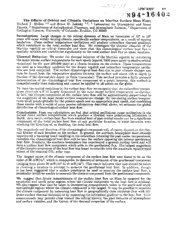
NASA Technical Reports Server (NTRS) 19940011929: The effects of orbital and climatic variations on Martian surface heat flow PDF
Preview NASA Technical Reports Server (NTRS) 19940011929: The effects of orbital and climatic variations on Martian surface heat flow
LPSC XXIV 971 - J N94_,lJ6 40. The Effects of Orbital and Climatic Variations on Martian Surface Heat "Flow; Michael T. Mellon 1,2 and Bruce M. Jakosky 1,3; 1 Laboratory for Atmospheric and Space Physics, _ Department of Astrophysical, Planetary, and Atmospheric Sciences, 3 Department of Geological Sciences, University of Colorado, Boulder, CO 80309. Introduction: Large changes in the orbital elements of Mars on timescales of 10 4 to 106 years will cause widely varying climate, specifically surface temperatures, as a result of varying insolation. These surface temperature oscillations will produce subsurface thermal gradients which contribute to the total surface heat flux. We investigate the thermal behavior of the Martian regolith on orbital timescales and show that this climatological surface heat flux is spatially variable and contributes significantly to the total surface heat flux at many locations. Thermal Behavior: We model the thermal behavior of the Martian regolith by calculating the mean annual surface temperatures for each epoch (spaced 1000 years apart to resolve orbital variations) for the past 200,000 years at a chosen location on the surface. These temperatures are used as a boundary condition for the deeper regolith and subsurface temperature oscilla- tion are then computed. The surface chmatologicalheat flux due to past climate changes can then be found from the temperature gradient between the surface and about 150 m depth (a fraction of the thermal skin depth on these timescales). This method provides a fairly accurate determination of the climatological heat flow component at a point; however, this method is computationally time consuming and cannot be applied to all points on the globe. To map the spatial variations in the surface heat flow we recognize that the subsurface temper- ature structure will be largely dominated by the most recent surface temperature oscillations. In fact, the climate component of the surface heat flow will be approximately proportional to the magnitude of the most recent surface temperature change. By calculating surface tempera- tures at all points globally for the present epoch and an appropriate past epoch, and combining these results with a series of more precise calculations described above, we estimate the global distribution of climatological surface heat flow. Conclusions: From our calculations we find that orbital oscillations cause oscillations in the annual mean surface temperatures which produce a thermal wave penetrating kilometers in depth. As a result, surface heat flux from residual heat of past orbital epochs can be a significant component of the total surface heat flow at any particular location, in some instances even reversing the direction of, or doubling, the total heat flow. The magnitude and direction of the climatological component will, of coarse, depend on the ther- mal history of each location on the surface. In general, the northern hemisphere most recently experienced a warming trend resulting in the subsurface retaining the past cooler temperatures, therefore the climatological heat flow will be into the surface opposing the interior geothermal heat flow. Similarly, the southern hemisphere has experienced a general cooling trend and will have a surface heat flow component which adds to the geothermal flux. The largest magnitude of the climate component of the heat flow was found to coincide with the maximum equatorward extent of the seasonal C02 polar caps. The largest values of the climate component of the surface heat flow were found to be on the order of 30 mW/m 2, which is comparable to theoretical estimates of the geothermal component (ranging from about 20 mW/m 2 to 45 mW/m2). This result indicates that care should be taken in choosing a location to attempt to measure the geothermal heat flow. In addition, though it has been suggested that a surface penetrator be used to measure the surface heat flow, a penetrator would be unable to separate the climate component from the geothermal component. We suggest that future measurements of the surface heat flow on Mars be targeted for the equatorial and south polar regions where the climate component to the heat flow is minimal. We also suggest that care be taken in interpreting measurements taken in the north and south mid-latitude regions where the climate component is the largest. It may be possible to separate the climate component by measuring heat flow at geographically close locations (but with dif- ferent surface thermal histories) or by measuring the latitudinal gradient in the heat flow. Such measurements may provide clues toward the orbital history, the past behavior of atmospheric and surface volatiles, and the history of the thermal properties of the surface.
